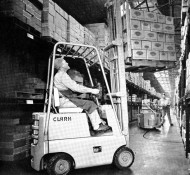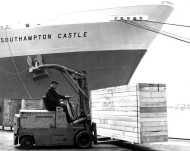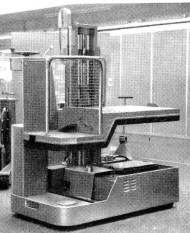 Warehouse & Logistics News is proud to bring you the thirty-ninth instalment in our exclusive series on the history of the fork lift truck, the machine that over the decades has revolutionised the face of materials handling around the world.
Warehouse & Logistics News is proud to bring you the thirty-ninth instalment in our exclusive series on the history of the fork lift truck, the machine that over the decades has revolutionised the face of materials handling around the world.
Our writer is James Brindley, an acknowledged authority on fork lift trucks. James’s distinguished career has involved engineering and management roles with BT Rolatruc and serving as a Director of the Fork Lift Truck Association, before he set up the National Fork Truck Heritage Centre in 2004 as Britain’s first such collection open to the public.
The Heritage Centre continues to need your support in 2009, and if you or your company would like to help in any way, you can contact James on the number below. Now sit back and enjoy the latest part of this fascinating series.
Episode 39: 1962: Earls Court Exhibition part 2
 Following ITD’s name change to Stacatruc Ltd in January 1962, the company began production of two new battery-powered counterbalance trucks called the C 20 and C 25. Built under licence from Stacatruc’s associate company Clark International, the machines were designed with lift capacities of 2000lb and 2,500lbs respectively. Introduced at the Earls Court Exhibition as the first trucks in the new Clarklift range, they introduced such features as the carbon pile resistor and an “I” beam inner section to the mast uprights. All mast and carriage rollers were bearing-mounted and adjustable together. A single control lever for lift and tilt operation was mounted on the right hand side of the steering column.
Following ITD’s name change to Stacatruc Ltd in January 1962, the company began production of two new battery-powered counterbalance trucks called the C 20 and C 25. Built under licence from Stacatruc’s associate company Clark International, the machines were designed with lift capacities of 2000lb and 2,500lbs respectively. Introduced at the Earls Court Exhibition as the first trucks in the new Clarklift range, they introduced such features as the carbon pile resistor and an “I” beam inner section to the mast uprights. All mast and carriage rollers were bearing-mounted and adjustable together. A single control lever for lift and tilt operation was mounted on the right hand side of the steering column.
In the larger electric forklift trucks on display, Coventry Climax added a new battery-powered truck of 8,000lbs lifting capacity to its ‘Universal Major’ range. Designated the model “MEE”, this machine was the largest in this particular range and was fitted with CC’s new double “I” beam mast to give increased strength and resistance to torsional stresses. The company stated that in the future all its new fork lift trucks would have this type of mast configuration.
 Boss catered for customers needing larger capacity machines with three new trucks within the 18,000-26,000lbs lifting capacity range. All were powered by the Perkins 6.354 diesel engine with Brockhouse TTT transmission, giving a maximum travel speed of 23mph in both forward and reverse.
Boss catered for customers needing larger capacity machines with three new trucks within the 18,000-26,000lbs lifting capacity range. All were powered by the Perkins 6.354 diesel engine with Brockhouse TTT transmission, giving a maximum travel speed of 23mph in both forward and reverse.
The biggest forklift trucks at the exhibition were to be found among the side-loaders, and one that stood out was the British-built and designed Lancer. Claimed by the Lancers Machinery Company to be the largest machine of its type in the world, it had a lifting capacity of 40,000lbs at 30-inch load centre. With its standard mast, it could lift a full load to 12 feet at a speed of 45 ft/min. The truck’s motive power was supplied by a Leyland 680 diesel engine, connected to a triple stage torque converter and a fully automatic power shift. Steering and braking were fully power-assisted to cope with this massive machine’s unladen weight of 55,000lbs.
 In the innovative machine category the Earls Court Show welcomed an interesting order picker, manufactured by AB C.J.Wennbergs Mechanista Verkstad Karlstad of Sweden. First launched in May 1961 at the International Packaging Exhibition in Holland and now seen for the first time in Britain at Earls Court, this one-man operated machine received plenty of attention. With a capacity of 1,650 lbs the load platform and operator could be raised to a maximum height of 10 feet, and travel at any height in between to access the items required. Three speeds in both forward and reverse were engaged through an automatic time delay unit, giving smooth acceleration up to 4 mph. Two foot-pedals controlled the raising and lowering of the platform, which also contained a ‘dead man’ facility. To receive the picked items, a 800mm x 1200mm pallet was carried on a roller conveyor platform sited next to the operator. This machine was one of their new range known as the “Jimmy” models and exhibited by Hi-Reach Trucks Ltd of Coventry as the sole distributors.
In the innovative machine category the Earls Court Show welcomed an interesting order picker, manufactured by AB C.J.Wennbergs Mechanista Verkstad Karlstad of Sweden. First launched in May 1961 at the International Packaging Exhibition in Holland and now seen for the first time in Britain at Earls Court, this one-man operated machine received plenty of attention. With a capacity of 1,650 lbs the load platform and operator could be raised to a maximum height of 10 feet, and travel at any height in between to access the items required. Three speeds in both forward and reverse were engaged through an automatic time delay unit, giving smooth acceleration up to 4 mph. Two foot-pedals controlled the raising and lowering of the platform, which also contained a ‘dead man’ facility. To receive the picked items, a 800mm x 1200mm pallet was carried on a roller conveyor platform sited next to the operator. This machine was one of their new range known as the “Jimmy” models and exhibited by Hi-Reach Trucks Ltd of Coventry as the sole distributors.
To be continued
By James Brindley, Director, National Fork Truck Heritage Centre
 If you would like to support the National Fork Truck Heritage Centre, please call James Brindley on 0780 195 4167
If you would like to support the National Fork Truck Heritage Centre, please call James Brindley on 0780 195 4167




Comments are closed.